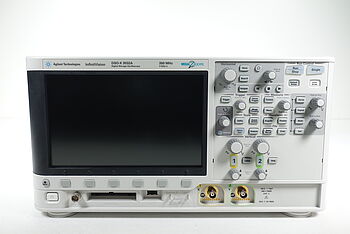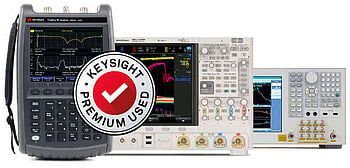- What is AC Coupling?
- The Concept of AC Coupling
- The Principle Behind AC Coupling
- What is a Capacitor?
- Implementation of AC Coupling
- Configurations of AC Coupling
- AC Coupling in Oscilloscopes
- Steps to Use AC Coupling in Oscilloscopes
- Interplay Between Oscilloscopes and AC Coupling
- Role of AC Coupling in Signal Visibility
- Different Oscilloscope Settings for AC Coupling
- Best Practices for Using AC Coupling in Oscilloscopes
- Oscilloscope Probes and AC Coupling
- When to Use AC Coupling on an Oscilloscope
- Advantages and Disadvantages of AC Coupling
- Advantages of AC Coupling
- Disadvantages of AC Coupling
- Selecting the Right Capacitor for AC Coupling
- Applications of AC Coupling
- Keysight Oscilloscopes
- Popular Used Oscilloscopes
Imagine conducting an intricate heart surgery without a proper diagnostic tool. An oscilloscope for an electrical engineer is just like that diagnostic tool, acting as a surgeon’s eyes. AC Coupling is a crucial and irreplaceable technique in the world of oscilloscope-based analysis, but is often undervalued.
This article delves into the realm of AC coupling, its principles, operations, applications, and advantages. Specifically designed for electrical engineers and related fields, this article explores the importance of AC coupling in oscilloscope utilization and signal analysis.
Buy Oscilloscopes at a Great Discount
The Concept of AC Coupling
AC coupling, also referred to as capacitive coupling, is a method used to transmit alternating current (AC) signals from one circuit to another while blocking direct current (DC). This technique removes the DC component of a signal, allowing engineers to focus solely on the AC element. It's like a selective bridge that only allows specific signals to cross while others are blocked.
The Principle Behind AC Coupling
AC coupling operates on the basic principle of a capacitor's nature. A capacitor:
- Allows AC signals to pass through
- Blocks DC signals
The capacitor used in AC coupling acts as a high-pass filter, eliminating the DC component and passing the AC component to the next stage.
What is a Capacitor?
Capacitors, often seen as the building blocks of AC coupling, play a crucial role in executing the function of this technique. In essence, a capacitor is a two-terminal electrical component that stores electrical energy in an electric field.
In AC coupling, the capacitor is used to create a high-pass filter. It passes signals with a frequency higher than a certain cutoff frequency and blocks those with a frequency lower than the cutoff. This frequency is determined by the value of the capacitor and the resistance of the circuit it's connected to.
| Key Takeaway |
|---|
| AC coupling is used in signal analysis to accurately measure AC components and avoid interference from DC signals. |
Implementation of AC Coupling
AC coupling is implemented by inserting a capacitor in series with the signal path. The capacitance value of this component is pivotal in determining the cut-off frequency of the high-pass filter.
Configurations of AC Coupling
Primarily, there are two configurations used for AC coupling:
- Source Coupling: Here, the coupling capacitor is connected at the signal's source. It's often used in the initial stages of signal processing.
- Load Coupling: In this configuration, the capacitor is connected at the load side. It's usually applied in the final stages of signal transmission.
AC Coupling in Oscilloscopes
AC coupling finds significant utility in oscilloscopes. It allows you to measure the AC content of a signal superimposed on a DC level. Without it, the oscilloscope could show a flat line if the AC signal variation is small compared to the DC level.
For instance, consider an AC signal of 100mV superimposed on a DC signal of 10V. Without AC coupling, the oscilloscope will display a line with a slight fluctuation around the 10V mark. But with AC coupling, the oscilloscope will show the AC signal distinctly, independent of the DC signal.
Steps to Use AC Coupling in Oscilloscopes
Using AC coupling in oscilloscopes is a straightforward process:
- Connect the probe to the oscilloscope.
- Select the channel to which the probe is connected.
- Choose the AC coupling option from the coupling settings.
- Adjust the vertical scale to observe the AC signal properly.
Remember, while transitioning from DC to AC coupling, a small transient may appear on the display due to the initial charging of the coupling capacitor. This is normal and will stabilize in a moment.

Interplay Between Oscilloscopes and AC Coupling
Oscilloscopes and AC coupling go hand in hand in the world of electronics. The use of AC coupling in oscilloscopes takes signal analysis to another level.
Role of AC Coupling in Signal Visibility
The primary role of AC coupling in an oscilloscope is to improve signal visibility. Without it, small AC signals superimposed on larger DC signals might go unnoticed. AC coupling isolates these AC components, allowing you to analyze them effectively.
Different Oscilloscope Settings for AC Coupling
Modern oscilloscopes offer various settings to utilize AC coupling effectively. Understanding these settings can help engineers fine-tune their signal analysis and diagnose potential issues more accurately.
Best Practices for Using AC Coupling in Oscilloscopes
Effective use of AC coupling in oscilloscopes requires not only the right setup but also a deep understanding of the signal under investigation. Applying best practices, like selecting the appropriate scale and managing transient responses, can further enhance the utility of AC coupling in oscilloscopes.
Oscilloscope Probes and AC Coupling
The type of oscilloscope probe used can impact the performance of AC coupling. Engineers need to make informed decisions about probe selection and calibration to ensure accurate signal readings when using AC coupling.
When to Use AC Coupling on an Oscilloscope
The decision to use AC coupling on an oscilloscope largely depends on the nature of the signal you are analyzing and the specific elements you're interested in studying.
- Analyzing AC Signals Superimposed on DC: If you're dealing with an AC signal superimposed on a large DC signal, using AC coupling can simplify your analysis. The AC coupling will effectively remove the DC component, allowing you to focus on the AC signal without being distracted by the large DC offset.
- Studying Small AC Variations: AC coupling can be incredibly useful when you're interested in observing small AC variations on a signal. With DC coupling, these minute variations could be overshadowed by the DC level and become difficult to observe. AC coupling will isolate these AC variations, making them more prominent on the oscilloscope display.
- Protecting the Oscilloscope: If there's a risk that the DC component of a signal might exceed the oscilloscope's voltage limit, you should use AC coupling. The AC coupling will block the potentially harmful DC signal, protecting your oscilloscope from any damage.
However, it's crucial to remember that AC coupling should not be used when you need to analyze signals with important DC content or very low frequency signals, as it can cause signal distortion. In these scenarios, DC coupling would be a better choice. Understanding the requirements of your signal analysis is key to effectively using your oscilloscope and making informed decisions about when to use AC coupling.
Advantages and Disadvantages of AC Coupling
AC coupling serves as a critical instrument in signal analysis, offering numerous benefits while posing a few challenges.
Advantages of AC Coupling
- Eliminates DC Offsets: It can efficiently remove DC offsets, providing a clearer view of the AC signal.
- Enhances Signal Analysis: By focusing on the AC component, it simplifies signal analysis and enhances detail observation.
- Provides Protection: It offers protection to the circuit by blocking DC voltages that could potentially harm the next stage in the chain.
Disadvantages of AC Coupling
- Can Distort Low-Frequency Signals: If the cut-off frequency of the coupling capacitor is higher than the frequency of the signal, it might result in signal distortion.
- Not Suitable for DC Signals: As it blocks DC components, it’s not suitable for analyzing signals with important DC content.
Selecting the Right Capacitor for AC Coupling
The capacitor's value and the resistance are decisive factors in AC coupling as they determine the high-pass filter's cut-off frequency. The following table provides a brief guideline for selecting the right capacitor:
| Frequency Range | Capacitance Value |
|---|---|
| High Frequency (MHz to GHz) | Low (pF to nF) |
| Medium Frequency (kHz to MHz) | Moderate (nF to μF) |
| Low Frequency (Hz to kHz) | High (μF to mF) |
Applications of AC Coupling
The usefulness of AC coupling extends beyond just oscilloscopes. It has many uses in the field of electronics, here are a few examples.
- Audio Systems: AC coupling is frequently employed in audio systems to eliminate any DC offsets that might harm speakers or distort audio signals.
- Communication Systems: AC coupling is used in radio and other communication systems to pass on the modulated signal while blocking any unwanted DC signals.
- Amplifiers: In amplifier circuits, AC coupling is used to block DC voltage levels that could distort the amplifier's operation.
- Power Supply Units: AC coupling is used in the design of power supply units to isolate the DC and AC components, improving the efficiency and stability of the supply.
- Test and Measurement Equipment: Apart from oscilloscopes, AC coupling is used in various other test and measurement equipment like spectrum analyzers and network analyzers for precise and undistorted signal analysis.
Browse Oscilloscopes at a Great Discount
Keysight Oscilloscopes
When it comes to tech equipment, you want the best of the best. That's why Keysight oscilloscopes are the perfect choice for your needs. With industry-leading performance, they're the ideal tool for many applications.
From basic signal analysis to complex measurements, Keysight digital oscilloscopes have you covered. With models ranging from entry-level to high-end, there's a Keysight oscilloscope that's perfect for your needs. So why settle for anything less? See Keysights Used Equipment to find a wide variety of oscilloscopes to fit your needs.

Popular Used Oscilloscopes
Keysight Used Oscilloscopes offers a wide range of industry leading pre-owened oscilloscopes, ranging from older generation Agilent oscilloscopes to the newest Keysight oscilloscope models. So whether you are a fist time buyer, replacing a model like-for-like or looking for upgrade – we have something for you.

































































































